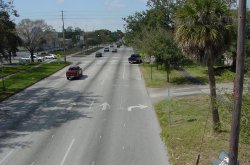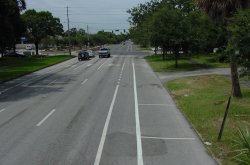The Truth about Lane Widths
Source: Pedestrian and Bicycle Information Center (PBIC)
The Influence of Lane Widths on Safety and Capacity: a summary of the latest findings.
Problem
The competition for space within a roadway right-of-way is fierce. It isn't just sidewalks and bike lanes battling "motor vehicle lanes" for the space. Drainage and utilities are also vying for their share of the right-of-way. And money for additional right-of-way is hard to come by. Also, adjacent property owners are not usually "friendly sellers" of land for roadway projects. Often times, something gets squeezed out - usually, it is the bicycle and/or the pedestrian facilities.
Background
When faced with having bike lanes, and possibly sidewalks, eliminated from a roadway project, advocates for bike and ped facilities may ask, "Can't we narrow the travel lanes to less than twelve feet?" Very likely, the engineers will list apparently good reasons for not wanting to reduce the travel lane widths: twelve foot lanes are the AASHTO standard; reducing lane widths reduces safety; narrowing lane widths reduces the roadway capacity. Surely, given these well known facts, no one would seriously suggest narrowing lanes.
But what if these well known facts aren't true? What if we could narrow the lanes on a roadway without adversely impacting the operations of the roadway? These questions have been asked and, in large part, answered. The following is The Truth about Lane Widths.
Solution
What is "the standard?"
The AASHTO Green Book (2011) is a guide. On the first page of its Foreword it states, "The intent of this policy is to provide guidance..." Many states, however, have adopted the values in AASHTO as "standards." However, when considering using its specified values for design criteria, one must keep in mind two other statements from the Green Book's Foreword,
"Minimum values are either given or implied by the lower value in a given range of values. The larger values within the ranges may be used where the social, economic, and environmental impacts are not critical."
With these fundamentals in mind, let's review the actual lane width guidance for urban arterial streets.
According to the AASHTO Green Book, for rural and urban arterials, lane widths may vary from 10 to 12 feet. It goes on to say that 12-foot lanes should be used where practical on higher speed, free flowing, principal arterials. However, lane widths of 10 feet may be used in more constrained areas where truck and bus volumes are relatively low and speeds are less than 35 mph. Given the above statements from AASHTO, 10-foot lanes should be considered the minimum standard .
But what about safety?
Safety is another oft cited reason for maintaining 12-foot lane widths. However, much research has been performed evaluating the crash impacts of narrowing lanes. This research found little to no support for the safety argument (with respect to urban roadways). Some of this research is summarized below:
NCHRP 330 Effective Utilization of Street Width on Urban Arterials, (1990) in its implementation guidelines states, "Narrower lane widths (less than 11 ft) can be used effectively in urban arterial street improvement projects where the additional space can be used to relieve traffic congestion or address specific accident patterns."
It goes on to note that, "all projects evaluated during the study that consisted exclusively of lane widths of 10 feet or more resulted in accident rates that were either reduced or unchanged."
And recommends, "Where streets cannot be widened, highway agencies should give strong consideration to the use of 10-ft lanes where they are necessary as part of a geometric improvement to improve traffic operations or alleviate specific accident patterns."
Most recently, the Midwest Research Center (Potts, Harwood, Richard, 2007) reported, "A safety evaluation of lane widths for arterial roadway segments found no indication, except in limited cases, that the use of narrower lanes increases crash frequencies. The lane width effects in the analyses conducted were generally either not statistically significant or indicated that narrower lanes were associated with lower rather than higher crash frequencies. There were limited exceptions to this general finding." [emphasis added]
And went on to say, "The research found three situations in which the observed lane width effect was inconsistent -- increasing crash frequency with decreasing lane width in one state and the opposite effect in another state. These three situations are:
- "lane widths of 3.0 m (10 ft) or less on four-lane undivided arterials.
- "lane widths of 2.7 m (9 ft) or less on four-lane divided arterials.
- "lane width of 3.0 m (10 ft) or less on approaches to four-leg STOP-controlled arterial intersections.
"Because of the inconsistent findings mentioned above, it should not be inferred that the use of narrower lanes must be avoided in these situations. Rather, it is recommended that narrower lane widths be used cautiously in these situations unless local experience indicates otherwise."
The Highway Safety Manual (2010) Chapter 12 (Urban and Suburban Arterials) does not include a CMF for the effect of lane width either for all crash types or for the specific crash types considered in HSM Chapters 10 and 11 (Rural Two-lane, Rural Multi-lane), nor does the chapter specify that the safety performance functions (SPFs) for roadway segments were developed taking into consideration a specific baseline condition (e.g., 12-ft lane width). In essence, HSM Chapter 12 is silent on the effect of lane width on crashes. HSM Chapter 12 does include a model for predicting pedestrian crash frequencies for pedestrian crossings at four-leg signalized intersections in urban and suburban areas. This model does not indicate the effect of changes in lane width on pedestrian crossing crashes, but the model does show that pedestrian crossing crashes increase as the number of lanes crossed by the pedestrian increases. This finding suggests the likelihood that the number of pedestrian crashes at a crosswalk increases with lane width.
Based upon the above cited research, it appears that narrowing lanes to less than the "standard" 12-ft width does not usually degrade safety.
Yes, but there's still the capacity issue.
The Highway Capacity Manual (HCM) (Transportation Research Board 2010) is the primary document used by planners and engineers to determine the capacity of roadways and intersections. In previous editions (most recently the 2000 HCM ) a lane width adjustment factor was included to reduce the saturation flow rate at signalized intersections for lane widths narrower than 12 feet. However, more recent (than the year 2000) research has found that
"The measured saturation flow rates are similar for lane widths between 10 feet and 12 feet. For lane widths below 10 feet, there is a measurable decrease in saturation flow rate. Thus, so long as all other geometric and traffic signalization conditions remain constant, there is no measurable decrease in urban street capacity when through lane widths are narrowed from 12 feet to 10 feet."(Zegeer 2007) [emphasis added]
Capacity, therefore, is not degraded until lane widths are reduced to less than 10 feet. The 2010 HCM has been revised to eliminate any saturation flow adjustments for lane widths between 10 and 13 feet wide.
Result

Before and after photos of 1st Avenue North at 49th Street in St. Petersburg, Florida. General travel lanes were narrowed to 10 feet to provide space for bike lanes. Image: Michael Frederick
In general safety and capacity are not adversely impacted by reducing lanes widths to as little as 10 feet. If we refer back to the AASHTO Green Book's Foreword and ask, "Are there critical social, environmental and economic reasons that would justify using less than 12-foot lanes?" The answer, in urban areas, is often "yes."
Accommodating pedestrians and bicyclists is a critical social issue: it makes our downtowns more livable, transit more viable, and provides for the mobility of those who cannot - or chose not - to drive. Accommodating more users in less space also addresses critical environmental issues: narrower lanes means less pavement (asphalt or concrete), less runoff, and less land consumed. Narrower (than 12-foot) lane widths reduce costs, a critical issue in times of shrinking budgets: smaller right-of-way costs, reduced costs for utility easements, reduced construction costs, reduced environmental mitigation costs.
In addition to these obvious considerations, by reducing lane widths and better providing for the mobility of all transportation system users, we can reduce our dependency on fossil fuels and reduce motor vehicle emissions. Furthermore, increased walking and bicycling resulting from the provision of facilities will promote active lifestyles, help combat the growing obesity epidemic, and contribute to healthier more active communities. Realizing and taking advantage of The Truth about Lane Widths provides benefits for everyone.
References
American Association of State Highway Transportation Officials. Geometric Design of Highways and Streets, pg. xli, AASHTO, Washington, D.C., 2011.
NCHRP Report 330 Effective Utilization of Street Width on Urban Arterials, Transportation Research Board, Washington, D.C., 1990.
Potts, I.B., Harwood, D., & Richard, K., Relationship of Lane Width to Safety for Urban and Suburban Arterials, TRR Volume 2023, pp. 63 - 82, Transportation Research Board, 2007.
American Association of State Highway and Transportation Engineers. Highway Safety Manual. AASHTO, Washington, D.C., 2010.
Transportation Research Board, Highway Capacity Manual, Transportation Research Board, National Research Council, Washington, D.C., 2010.
John Zegeer, P.E., (past Chair, TRB Highway Capacity and Quality of Service Committee) in a memo to Sprinkle Consulting Engineers, March 22, 2007.
Contact
Theodore A. Petritsch, P.E., PTOE
Senior Transportation Engineer
Sprinkle Consulting, Inc.
18115 US Hwy 41 N, Suite 600
Lutz, FL 33549
(813) 949.7449
tap@sprinkleconsulting.com
Image source
Michael Frederick





